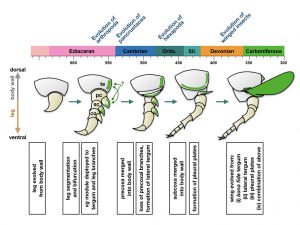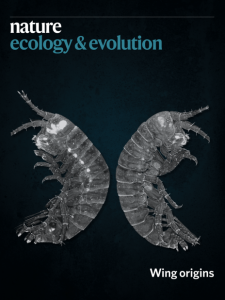Latest News:
May. 2021: a Q&A about the periodical cicadas!
March. 2021: A new review on wing origin studies using crustaceans is now published in Current Opinion in Genetics & Development!

Jan. 2021: Our paper investigating wing-related tissues in cockroaches is now published in Evolution & Development!


Dec 2020: Our latest paper on the search for wing-related tissues in crustaceans is featured on the cover of Nature ecology & evolution (vol4 issue12)!
Also see the News&Views featuring our article.
The world is full of fascinating diversity of life. Understanding the mechanism that has driven (and still is driving) this amazing diversity is important not only for science, but also for our life itself. Knowledge of the history of life (including humans) affects our way of thinking, our culture, and our society. Only recently, we have finally begun to understand the molecular basis of morphological evolution. Our research interest is to understand how changes in patterning mechanisms have contributed to the evolution of morphological diversity.
Questions
One of the important concepts that modern developmental biology has provided is that the structure and function of genes important for development are well conserved across animal taxa, even between insects and mammals. However, it is usually less emphasized that these same apparently well-conserved genes are responsible for producing the amazing array of diverged morphologies found among metazoans. This is a fascinating paradox that we study in our lab. How do these developmental genes produce diverse structures when they are evolutionarily so well conserved? What are the major modes of change that have been driving morphological evolution (changes in interactions between gene products, changes in gene expression regulation, changes in the function of genes, or even gaining new genes)? What is the molecular and developmental basis underlying the evolution of morphologically novel structures? These are some of the questions we would like to answer through our research program.
Insect wings as a model to study morphological diversity
The impressive diversity of insect wings makes them an excellent model to study the molecular basis behind morphological evolution. We have been investigating the conserved and diverged aspects of genetic mechanisms responsible for wing development in various insects, including the fruit fly (Drosophila melanogaster) and the red flour beetle (Tribolium castaneum), in order to elucidate the changes in genetic mechanisms that have contributed to the evolution and diversification of insect wings.
Previous works
Our research has provided several novel insights into the genetic basis of morphological evolution, which include the elucidation of distinct Hox action between beetles and flies (Tomoyasu et al., Nature 2005) and uncovering the multiple co-options of exoskeleton formation into the conserved wing gene network during beetle wing evolution (Tomoyasu et al., Cur. Bio. 2009). (reviewed in this)
More recently, we have also obtained novel insight into the origin of insect wings (Clark-Hachtel et al., PNAS 2013). Despite the fact that insect wings are often used as an example of morphological novelty, the origin of insect wings remains a mystery and is regarded as a major conundrum in biology. Our work paved a new way to approach this century-long conundrum from an evolutionary and developmental (evo-devo) perspective (reviewed in this and this).
More in-depth explanations of our previous work
Current and Future Research
Most genetics and developmental biology studies still depend heavily on a handful of established model organisms. However, to extend our knowledge of the molecular basis of morphological diversity, we need to investigate the detailed molecular and genetics mechanisms underlying development in various organisms. One of our long-term goals is to analyze a wide taxonomy of insects and other arthropods at the level that is currently achievable only in some established model organisms, which will provide us with a more comprehensive view of the molecular basis underlying morphological evolution. To achieve this goal, we have been applying various modern genetic and genomic techniques, such as RNAi-based gene knockdown, transcriptome analysis via RNA sequencing, genome-wide chromatin profiling, and CRISPR/Cas9-based genome editing, to non-traditional model organisms. In addition, although Drosophila and Tribolium have been our primary model organisms, we have started using several additional organisms (cockroaches, mayflies, and amphipods, etc.) to gain further taxonomic breadth within our research.
Our current research has two major directions. One is an expansion of our past studies regarding molecular mechanisms underlying insect wing diversity. This direction has several branches, including the investigation of cis changes that have contributed to the production of diverged wing morphology. The second direction is to elucidate the origin of insect wings. This is a new direction for our research stemming from our more recent work (Clark-Hachtel et al., 2013).
More in-depth explanations of our current works
Our research program is funded by National Science Foundation
IOS1557936
![]() Lobes or Gills, Exploring the Origin of Insect Wings
Lobes or Gills, Exploring the Origin of Insect Wings
IOS0950964
![]() Molecular mechanisms contributing evolutionary morphological diversity
Molecular mechanisms contributing evolutionary morphological diversity

